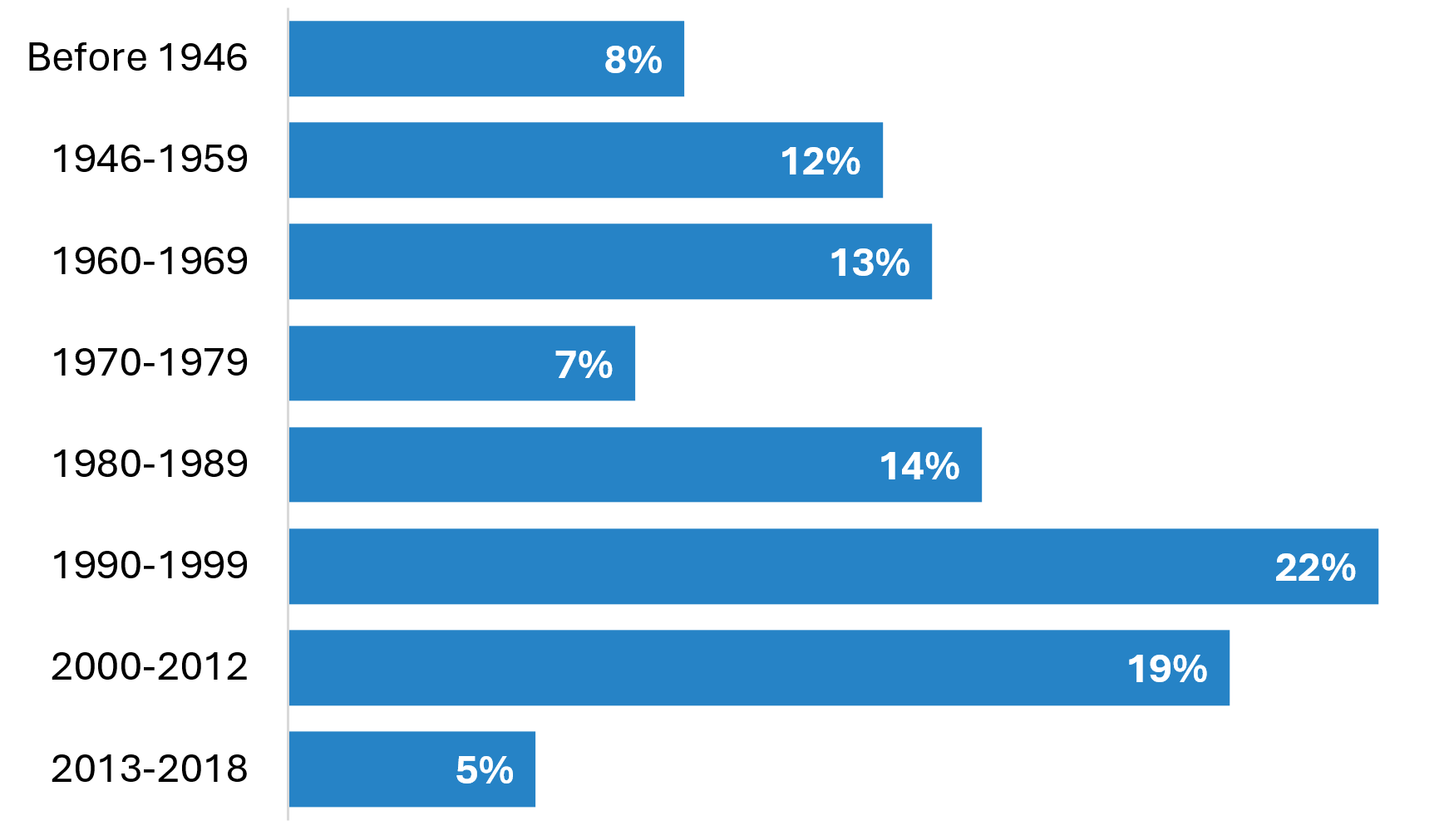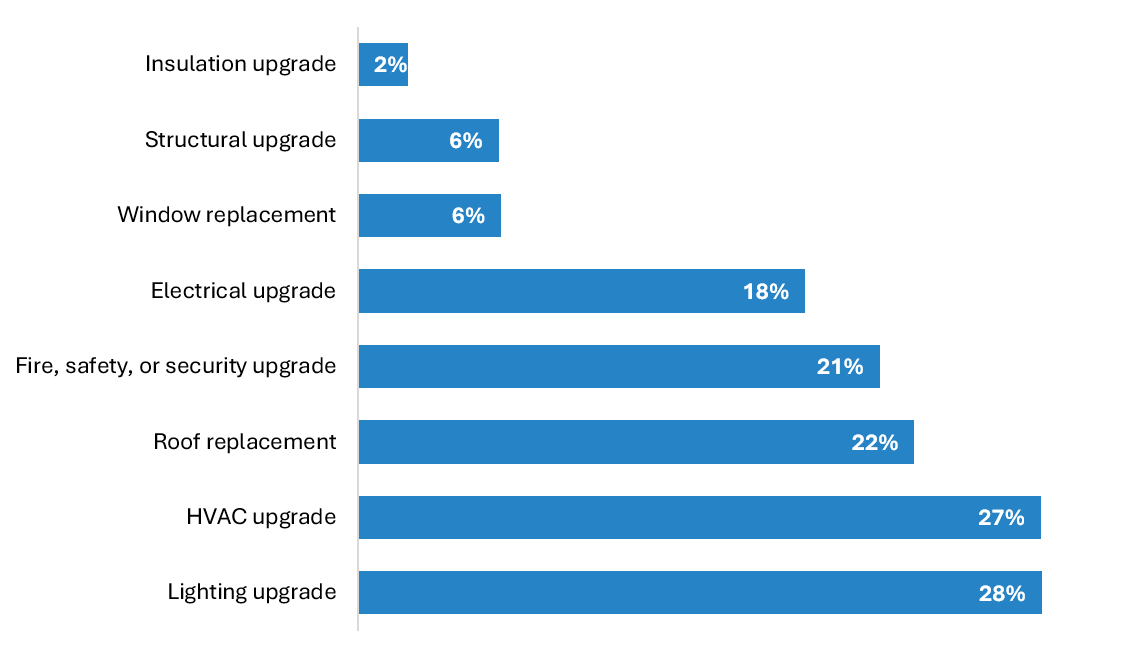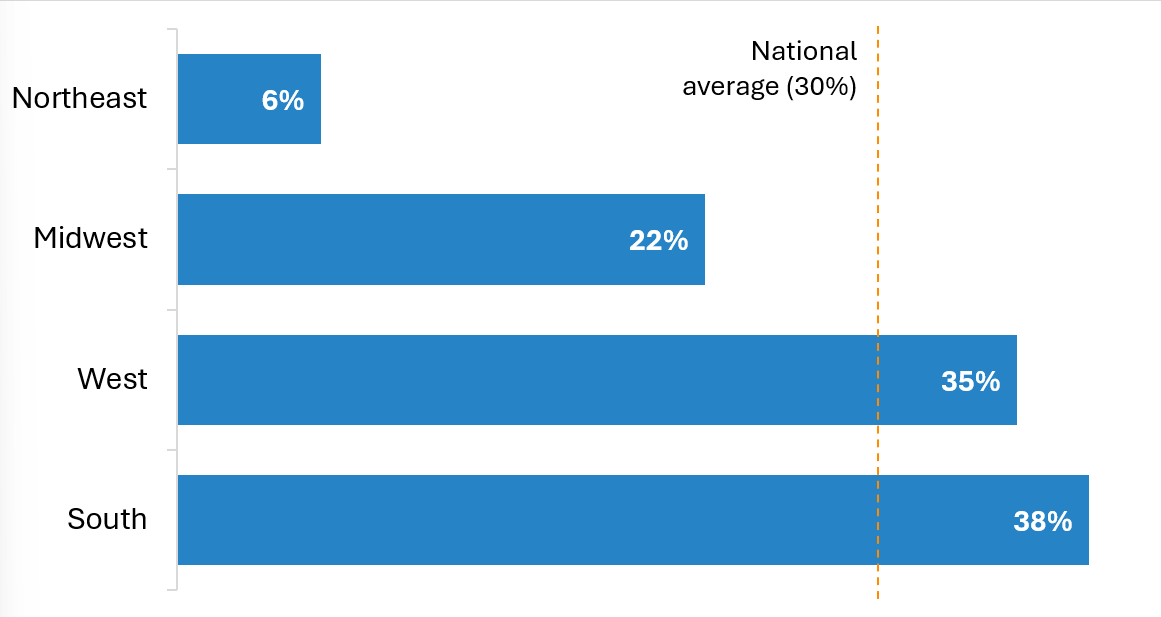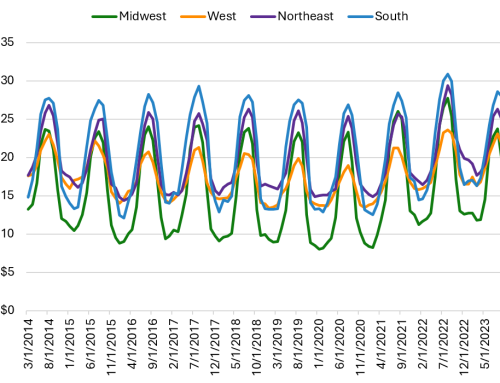
A recent report by Healthy Buildings, a partnership between For Health and the Harvard T.H. Chan School of Public Health, found that governmental investment in public schools for maintaining building quality and ensuring environmental health is at a deficit of $46 billion annually. Moreover, the nearly 130,000 K-12 schools in the United States spend about $6 billion on energy bills, but about a third of this energy is wasted due to structural building inefficiencies. And when these problems go unaddressed, they lead to declines in both student health and scholastic performance.
Data from the Department of Energy’s 2018 Commercial Buildings Energy Consumption Survey (CBECS) was released in December 2022. Educational facilities are classified as commercial buildings in CBECS, and for the purposes of this article, only elementary, middle, high, and multi-grade K-12 schools are included in our analysis. This data story examines the state-of-play for building electrification and decarbonization at American K-12 schools, drawing from Buildings Hub and the 2018 CBECS.
Breaking down the educational building stock
While the age of the K-12 school building stock varies, around 54 percent of these facilities were constructed before 1990 (Figure 1).
Figure 1: Share of Total K-12 Educational Facilities by Decade Constructed
Source: EIA CBECS, 2018
Generally, older buildings tend to be insufficiently weatherized, have pre-existing fossil fuel-based infrastructure, and be built to older building codes, making them less energy efficient. A lack of recent renovations, particularly for insulation (Figure 2, 2 percent), serves as a roadblock to effective building electrification as the building itself is not properly weatherized and would leak heat.
Figure 2: Share of Renovated K-12 Educational Buildings Since 2000 by Renovation Type
Source: EIA CBECS, 2018 | Note more than one activity may apply for a given building. As such, percentages will not add up to 100.
At the same time, it is encouraging to see that 27 percent of educational buildings have undergone HVAC system upgrades — involving improvements to heating, ventilation, and air conditioning systems — over the past two decades. The 18 percent of educational buildings that underwent electrical upgrades, the six percent with window replacements, and two percent that received insulation upgrades are all likely to experience much improved energy efficiency.
Unfortunately, it seems as though a majority of educational buildings rely on fossil heating equipment; 30 percent of K-12 educational buildings nationwide are equipped with heat pumps while another six percent rely primarily on district heat or steam technologies. In terms of primary heating fuel, 45 percent of K-12 educational buildings rely on natural gas; 42 percent depend on electricity, nine percent district heat, and four percent (mostly in the Northeast) use fuel oil.
Figure 3: Share of K-12 Schools with Heat Pumps for Space Heating by Region
Source: EIA CBECS, 2018
The South leads on heat pump deployment, with 38 percent of educational buildings in the region equipped with the efficient electric appliances, while the Northeast lags with a regional heat pump penetration rate of just five percent (Figure 4). 30 percent of all schools in the United States currently depend on heat pumps for primary space heating, with the Northeast lagging the national average by a whopping 24 percentage points. School districts in the Northeast and Midwest should consider investing in cold climate air source heat pumps — which perform well even when faced with subfreezing temperatures — or geothermal heat pumps — which deliver regardless of outdoor temperature and are the most efficient way to heat and cool a building.
Figure 4: Primary Space Heating Mix in K-12 Educational Buildings by Region
Source: EIA CBECS, 2018
The school portfolios in the Northeast and the Midwest have the most carbon-intensive heating mixes in the country; 64 and 78 percent of the educational facilities in these regions are heated directly with fossil fuels, respectively (Figure 5). In addition, a large proportion of district heating in the Northeast is also derived from the burning of hydrocarbons to heat water and generate steam, and the region is uniquely reliant on fuel oil and propane for school heating.
In comparison, much larger shares of Southern and Western educational buildings are heated with electricity, 56 and 51 percent of buildings, respectively. In total, about 59,000 K-12 schools in the South are either heated with electricity or do not have heating equipment, about the same as the 57,000 educational buildings in the West. These absolute totals dwarf the 20,000 Northeastern and 27,000 Midwestern educational buildings heated directly with fossil fuels.
Figure 5: Primary Fuel Used in K-12 Educational Buildings by End Use (United States)
Source: EIA CBECS, 2018
The national heating and cooling mix at American K-12 schools offers an interesting mosaic. Across the country, around 40 percent of all educational buildings are primarily heated using natural gas, with 33 percent reliant on natural gas for water heating (Figure 6). Nationally, electricity is the primary fuel source used for water heating (43 percent) and building cooling (89 percent). District heating systems are only employed by about six percent of educational buildings while about two percent utilize them for water heating.
State-level policies enable electrification
At least a dozen states tracked on the Buildings Hub Spotlight States dashboard currently operate programs focused on school decarbonization and electrification (Figure 6). Most of these programs primarily seek to increase the energy efficiency or improve air ventilation at educational buildings.
Figure 6: States with Programs Encouraging K-12 Educational Building Electrification
Source: Atlas Buildings Hub, Spotlight States Dashboard | Visualization is only inclusive of states tracked by Atlas Buildings Hub. States in light grey are not included in Buildings Hub Spotlight States.
The California Energy Commission operates the California Schools Healthy Air, Plumbing, and Efficiency Program (CalSHAPE), which offers sub-programs for specific retrofitting needs. Currently, its Plumbing and Ventilation Programs are open to applications to help educational agencies meet water efficiency standards and improve HVAC systems through assessments, maintenance, and replacements.
In the Midwest, Minnesota is working to get more solar panels on public school roofs. The $21 million Minnesota Solar for Schools Program helps public K-12 schools located outside Xcel Energy’s electric service territory deploy rooftop solar systems, with funding allocated based on financial need. Schools within Xcel’s territory will be able apply on a separate track beginning in January 2024. Likewise, the program also supports the integration of coursework about renewable energy into grantee school curricula.
Over in Maryland, the state’s $20 million Decarbonizing Public Schools Program takes a wider approach than Minnesota’s solar schools initiative, with FY24 funding eligible for energy benchmarking, net-zero energy design planning, energy efficiency improvements, and solar installations. Schools may apply for “multiple areas of interest,” which would be supported by the $20 million set aside for the program.
New York’s Clean Green Schools Initiative and Ohio’s Nonprofit Hospitals & Schools Energy Efficiency Grant are notable in that they are explicitly focused on supporting low-income and disadvantaged communities. New York’s Clean Green Schools Initiative serves state public schools “that traditionally lack resources,” enabling investment in energy efficiency improvements and improving indoor air quality to better support student learning. The Track I Planning program is currently open to facilitate school planning for efficiency upgrades.
A rare offering from a Republican-led state, Ohio’s program has made $800,000 available for the purchase and installation of energy efficient “materials,” like insulation and multipaned windows. The program renews annually and specifically aims to help awardees realize at least 15 percent energy savings. This program only supports Ohio school districts located in a disadvantaged community (per the Climate and Economic Justice Tool), designated as rural and high poverty, or those where at least 45 percent of students are enrolled in free or reduced-price lunch programs.
Lastly, Colorado’s Public Building Electrification Grant and Washington’s Energy Retrofits for Public Buildings program do not specifically target educational buildings, but list schools or school districts as eligible applicants. Colorado’s $10 million program is currently open and accepting applications on a rolling basis, with eligible projects including the purchase and installation heat pumps, heat pump water heaters, and electric stoves. Likewise, Washington’s program supports public agencies improve energy efficiency through a broad range of eligible electric-only upgrade and retrofit projects, and the initiative’s latest batch of awardees included four school districts.
IIJA and IRA funding begins to bridge the gap
While certain states around the country have appropriated funds to decarbonize schools and improve student air quality, financial support for this purpose varies widely around the United States. As such, federal funding, largely from the Inflation Reduction Act (IRA) and the Infrastructure Investment and Jobs Act (IIJA), provides new nationwide opportunities for states and school districts to make these critical improvements.
Created as part of IIJA, the $500 million Renew America’s Schools Program aims to support the “implementation of clean energy improvements at K-12 public schools” and prioritizes high-need schools. A number of energy infrastructure improvement projects are identified as eligible costs, including the purchase and installation of new HVAC systems, weatherization upgrades, lighting retrofits, and rooftop solar deployment. First-round grantees were announced in June 2023, with a second application round expected spring 2024.
Established under the IRA, the soon-to-be-released Funding to Address Air Pollution at Schools program will help low-income and disadvantaged educational facilities monitor and reduce air pollution and identify and address existing onsite environmental health hazards. A total of $37.5 million in competitive grants will be made available in December 2023, and an additional $12.5 million will be available for schools to apply for technical assistance.
In terms of tax policy, schools are also now eligible for direct pay under the Section 48 Investment Tax Credit for Energy Property. That means that schools that install a geothermal heat pump, thermal energy network, solar panels, or any other technology defined as “clean energy production” under the credit can claim and receive a tax refund on these projects even if they don’t pay federal taxes as nonprofit entities. Under 48, schools would be able to receive up to 50 percent of the project cost back as direct funding from the Internal Revenue Service.
Looking toward the future of student health and safety
IIJA and IRA provide significant, needed investment for improvements to K-12 educational buildings. But much more federal funding will be necessary to retrofit schools across the country and ensure students have access to a healthy learning environment nationwide. As such, an additional funding bill is currently under development in Congress: Rep. Jamaal Bowman and Sen. Ed Markey’s Green New Deal for Public Schools. Presented in September 2023, this initiative would spur $1.6 trillion in investment over the next decade in public and Bureau of Indian Education schools, eliminating an estimated 78 million metric tons of carbon emissions. All in all, the plan would invest $160 billion a year in public education buildings, making significant strides in closing the annual $50 billion funding deficit for those schools.
Climate resilience and equity are cardinal pillars of the plan. More than $485 billion is earmarked to retrofit every single public-school building in the United States, beginning with districts that have the highest need. The plan would carve out $100 million for the Educational Equity Planning Grants Pilot Program to rectify historical funding inequities. While the Green New Deal for Public Schools is not expected to become law, its development symbolizes a larger political and social appetite for improvements in public school energy efficiency and environmental health outcomes.
American K-12 public schools have seen continued underinvestment for years, and many of the buildings are insufficiently weatherized and require structural and envelope upgrades. Moreover, many buildings rely upon legacy fossil HVAC systems; the whole unit will need to be ripped out and replaced as part of a full-building retrofit, posing a financial and logistical challenge for school districts. While the recent influx in public funding for K-12 educational buildings from the IRA, IIJA, and state programs represent a promising starting point, funding must be maintained and expanded to make good on our decarbonization goals and meaningfully improve environmental health for public school students nationwide.








